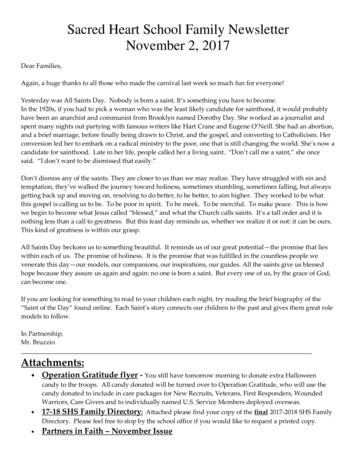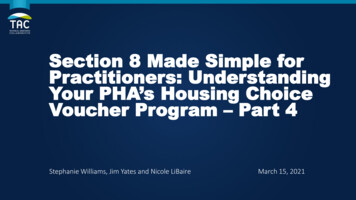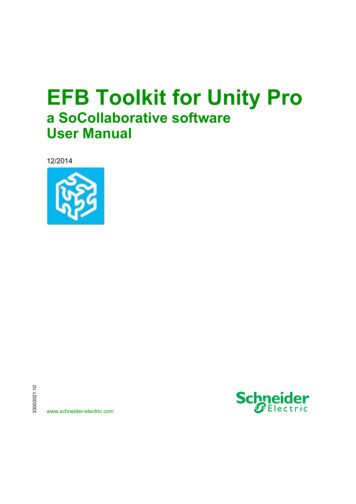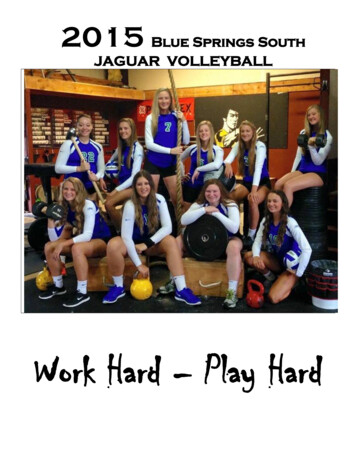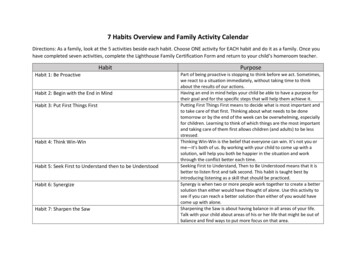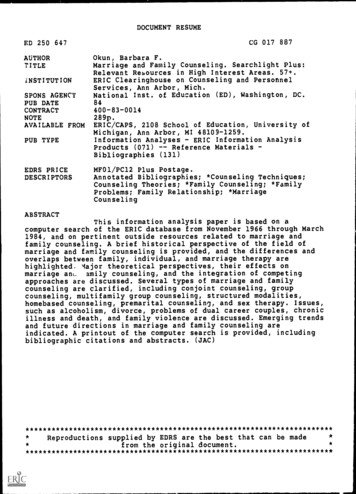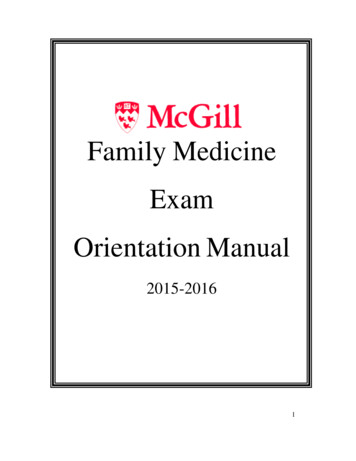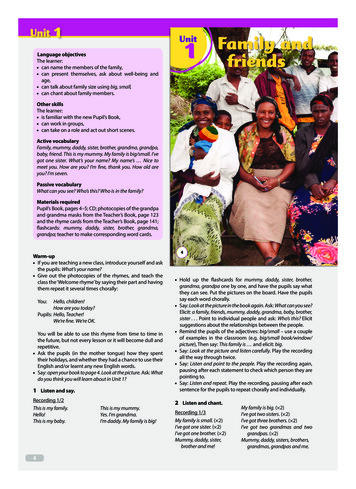
Transcription
Unit1Unit1Language objectivesThe learner:can name the members of the family,can present themselves, ask about well-being andage,can talk about family size using big, small,can chant about family members. Family andfriends Other skillsThe learner:is familiar with the new Pupil’s Book,can work in groups,can take on a role and act out short scenes. Active vocabularyFamily, mummy, daddy, sister, brother, grandma, grandpa,baby, friend. This is my mummy. My family is big/small. I’vegot one sister. What’s your name? My name’s Nice tomeet you. How are you? I’m fine, thank you. How old areyou? I’m seven.Passive vocabularyWhat can you see? Who’s this? Who is in the family?Materials requiredPupil’s Book, pages 4–5; CD; photocopies of the grandpaand grandma masks from the Teacher’s Book, page 123and the rhyme cards from the Teacher’s Book, page 141;flashcards: mummy, daddy, sister, brother, grandma,grandpa; teacher to make corresponding word cards.Warm-upIf you are teaching a new class, introduce yourself and askthe pupils: What’s your name?Give out the photocopies of the rhymes, and teach theclass the ‘Welcome rhyme’ by saying their part and havingthem repeat it several times chorally:4 Hello, children!How are you today?Pupils: Hello, Teacher!We’re fine. We’re OK. You: You will be able to use this rhyme from time to time inthe future, but not every lesson or it will become dull andrepetitive.Ask the pupils (in the mother tongue) how they spenttheir holidays, and whether they had a chance to use theirEnglish and/or learnt any new English words.Say: open your book to page 4. Look at the picture. Ask: Whatdo you think you will learn about in Unit 1? 1 Listen and say.Recording 1/2This is my family.Hello!This is my baby.This is my mummy.Yes. I’m grandma.I’m daddy. My family is big!Hold up the flashcards for mummy, daddy, sister, brother,grandma, grandpa one by one, and have the pupils say whatthey can see. Put the pictures on the board. Have the pupilssay each word chorally.Say: Look at the picture in the book again. Ask: What can you see?Elicit: a family, friends, mummy, daddy, grandma, baby, brother,sister . . . Point to individual people and ask: Who’s this? Elicitsuggestions about the relationships between the people.Remind the pupils of the adjectives: big/small – use a coupleof examples in the classroom (e.g. big/small book/window/picture), Then say: This family is and elicit: big.Say: Look at the picture and listen carefully. Play the recordingall the way through twice.Say: Listen and point to the people. Play the recording again,pausing after each statement to check which person they arepointing to.Say: Listen and repeat. Play the recording, pausing after eachsentence for the pupils to repeat chorally and individually.2 Listen and chant.Recording 1/3My family is small. ( 2)I’ve got one sister. ( 2)I’ve got one brother. ( 2)Mummy, daddy, sister,brother and me!My family is big. ( 2)I’ve got two sisters. ( 2)I’ve got three brothers. ( 2)I’ve got two grandmas and twograndpas. ( 2)Mummy, daddy, sisters, brothers,grandmas, grandpas and me.497557 U01 004-017.indd 407/01/16 11:42 am
Family andfriends3 Listen and play.Recording 1/4Hi grandma. This is my friend.Good morning, nice to meet you. What’s your name?Good morning. My name is Tomek. Nice to meet you, too.This is my sister, Lucy.Hi Lucy, how are you?Hi Tomek. I’m fine, thank you. How are you?Fine thanks.Grandpa, this is my friend, Zosia.Hello, Zosia. It’s nice to meet you.It’s nice to meet you, too.How old are you, Zosia?I’m seven. You will learn: to say where you are from and ask others to say how old you are and ask others to talk about family and friends.1 Listen and say.2 Listen and chant.3 Listen and play. 1/21/3 1/45Say: Listen carefully. Play the recording all the way through.Divide the class into groups of three, to play the charactersin each of the three scenes.Give each group the grandma and grandpa masks to takeit in turns to wear. The other pupils are the grandchild/introducer, sister Lucy and the friend (Zosia or Tomek).Have them stand up, and decide on their roles for thefirst dialogue. Play the recording and get them to actout the dialogue without speech. Then play it againand have them talk along with the recording. Third timethrough, they should do the dialogue alone. Circulateand help them.Repeat the process with the other two dialogues. Youcan do the whole thing several times, with the pupilschanging roles within each group.Additional activity Say: Listen carefully. Play the recording all the way throughonce.Play the first part again. Ask: Is it a big family or a small family?(small family). Ask: Who is in the family? Elicit: Mummy, daddy,sister, brother and me.Play the second part and work in the same way.Say: Listen and repeat. Play the recording, pausing after eachline for the pupils to repeat.Have the pupils say the chant in four groups, each groupsaying a pair of lines, and all of them joining in for the last line.Additional activity Divide the class up, each with a role: mummy, daddy,sisters (2), brothers (3), grandmas (2), grandpas (2).Play the recording, and the pupils say their ‘character’ atthe correct moment in the chant.Practise a couple of times. You could then ask a volunteerto be the ‘narrator’ and say the rest.Finally, have the pupils say the chant without the recording.Play a guessing game with the class. Say the firstsyllable of the name of a member of the family andhave individuals complete it.ClosureGive out the photocopies of the rhymes, and teach theclass the ‘Goodbye rhyme’ by saying their part and havingthem repeat it several times chorally: You:Pupils:You:Pupils:Have a nice day, children!And the same to you!Bye bye for now!Goodbye! See you soon!As with the ‘Welcome rhyme’ above, you will be able touse this rhyme from time to time in the future, but not inevery lesson or it will become dull and repetitive.Materials for the next lessonFlashcards: daughter, son, aunt, uncle, parents; teacherto make corresponding word cards; photocopies of themummy and daddy masks from the Teacher’s Book,page 125.597557 U01 004-017.indd 507/01/16 11:42 am
Unit1 Family and 1LessonI’m your aunt.friendsLanguageobjectivesThe learner:can name the family members: daughter, son, aunt,uncle, parents,can understand the contents from listening to the story,can read the sentences in the story,can relate the family names to the characters in thestory,can write the names of family members on the staves,can talk about family members with a partner. daughtersonauntuncleparents 1 Listen and say. Story1/5corner 2 Listen and read.1/6 Other skillsThe learner:can play Chinese Whispers.1Daddy, this is my friend.2What’s your name?Nice to meet you.My name’s Yoko. Active vocabularyMummy, daddy, grandpa, grandma, daughter, son, aunt,uncle, parents. This is my friend. Nice to meet you. What’syour name? My name’s I’m your uncle. You’re my friends.Passive vocabularyYour parents are great. Who’s in the mask?3Materials requiredPupil’s Book, pages 6–7; CD; Activity Book, pages 2–3;flashcards: daughter, son, aunt, uncle, parents; teacherto make corresponding word cards; photocopies of themummy, daddy, male crocodile and female crocodilemasks from the Teacher’s Book, pages 125, 127 and 129.Warm-upHave the pupils do the chant they learnt in the previouslesson (Recording 1/3).Tell the pupils that in this lesson they will learn the namesof more family members.I’m your uncle.4You’re my friends!I’m your aunt.61 Pupils learn and say the new words, paying special attention to their pronunciation.2 Pupils listen to the dialogue, follow the story and read the sentences. TBTB 1 Listen and say.Recording 1/5daughter, son, aunt, uncle, parents Say: Open your book to page 6. Look at the pictures at thetop of the page. Ask: Who can you see? Elicit some knownvocabulary, e.g. mummy, daddy, baby.Say: Look at the pictures and listen carefully. Play therecording all the way through twice.Say: Listen and repeat. Play the recording, pausing aftereach word for the pupils to repeat chorally and individually.Ensure that the pupils understand what these five familynames mean.Hold up the flashcards for daughter, son, aunt, uncle,parents one by one, and have the pupils say what they cansee. Put the pictures on the board.Give volunteers the word cards one by one and ask themto put them under the correct picture. Have the pupils sayeach word chorally.Activity Book, page 3, activity 3. Say: Find the family wordsand circle them, then read them out to your partner.2 Listen and read.Recording 1/6Frame 1Hello, daughter!Daddy, this is my friend.Hello, what’s your name?I’m Yoko. Nice to meet you.Nice to meet you too, Yoko.Frame 2Hello, son!Mummy, this is my friend.Hello, what’s your name?My name’s Yoko.How are you, Yoko?I’m fine, thank you.Your parents are great!Frame 3Hello, Snap.Em Hello?I’m your uncle.I’m your aunt.Frame 4I’m Honey!I’m Chatty!You’re my friends!697557 U01 004-017.indd 607/01/16 11:43 am
Lesson13 Read and match.uncledaughterAdditional activitymummy auntsondaddy 4 Write and read. mummydaddy3 Read and match. grandmagrandpa sisterbrotherauntuncle son 5 Play.3 Pupils read the words and match them with the photos.4 Pupils trace over the words and read them aloud.5 Pupils play Chinese Whispers. TBSay: Open your book to page 7. Look at the two pictures inactivity 3. Ask: Who can you see? Elicit the family names. Readthem all with the whole class, chorally and individually.Say: Draw a line from the words to the correct people.Check their answers by pointing to the people in thephotos and asking: Who’s this?4 Write and read. daughterMake photocopies of the masks on pages 125, 127 and129. Put the pupils in groups of three and give eachgroup a set of masks (mummy, daddy, male crocodile,female crocodile).Ask them to decide who has which role in each frame.Then play the recording, and have individuals saytheir character’s lines along with it. Then ask them todo it without the recording. Circulate and check theirproduction.Do it again having the pupils change roles.7Say: Look at the words in activity 4. Read them aloud. Havethe pupils read the words chorally.Say: Write the five words on the stave. The pupils shouldbe familiar with writing on a stave from Level 1. Theycan simply trace over the words in the Pupil’s Book ifthe handwriting style complies with what you want.Otherwise, ask them to use ink and write the samewords in their own style on top. Circulate, checking andhelping them.5 Play. Say: Look at the four pictures in activity 2. Ask: Who can you see?Elicit the character names.Say: Look at the pictures and listen carefully. Play the recordingall the way through once.Say: Look at picture 1. Who’s in the mask? (Fred). Repeat forpictures 2 (Kate) and 3 (Honey/Chatty). Explain the meaning ofYour parents are great!Divide the class into three groups. Group 1 – Kate; Group 2 –Fred (Daddy); Group 3 – Yoko. Play the recording for Frame 1for the pupils to listen. Then play it again for the groups tosay their character’s lines chorally along with the recording.Repeat. Then have them do it without the recording.Use the same procedure for the other three frames.Put the class into groups of three. They should decide whohas which role in each frame. Then play the recording, andhave individuals say their character’s lines along with it. Thenask them to do it without the recording. Circulate and checktheir production.Activity Book, page 2, activity 2. The pupils must close theirPupil’s Books while doing this activity. Play Recording 1/6.Say: Listen to the recording and number the pictures one to fourin the boxes. Play Chinese Whispers.Have the pupils sit on the floor in teams of five or sixin a line – the teams should be as far from each other aspossible.Whisper one of the family words into the ear of the firstpupil and have them pass it back along the line. Checkwhat the last person says. You can award points to theteams, as you continue the game with different words.HomeworkActivity Book, page 2, activity 1. Say: Read the words anddraw a line to match them to the pictures. Write the words onthe staves, then say them aloud.Activity Book, page 3, activity 4. Say: Draw a picture of yourparents, then write the sentences on the staves. Material for the next lessonFlashcards: boy, girl, grandparents, granddaughter,grandson; teacher to make corresponding word cards.797557 U01 004-017.indd 707/01/16 11:43 am
Unit1 Family and 2LessonA happy familyfriendsLanguageobjectivesThe learner:recognises and can name the people: boy, girl,grandparents, granddaughter, grandson,can read the words,can follow the text when listening to the recording,can indicate the people in the picture according to therecording,can say sentences about the family after listening tothe recording,can write known words on the stave. boygirl grandparents granddaughter grandson 1 Listen and say. 1/7 2 Listen and read. 1/8 Other skillsThe learner:knows how to play Hunt the Thimble. Active vocabularyBoy, girl, grandparents, granddaughter, grandson, happy,a good grandson/granddaughter.Passive vocabularyWhat’s the boy’s name? What’s the girl’s name? What aretheir grandparents’ names? Are they a happy family? Who’sAnders in the family?Materials requiredPupil’s Book, pages 8–9; CD; Activity Book, pages 4–5;flashcards: boy, girl, grandparents, granddaughter,grandson; teacher to make corresponding word cards.Look at this family. The boy is Anders and the girl is Linda. Theirgrandparents are Marit and Henrik.Anders is a good grandson and Linda is a good granddaughter.They are a happy family.Warm-upElicit the family names the pupils have learnt so far.Tell them that they are going to learn some new ones inthis lesson.81 Pupils learn and say the new words, paying special attention to their pronunciation.2 Pupils listen to the recording, follow the text and read it aloud. TBTB 1 Listen and say.Recording 1/7boy, girl, grandparents, granddaughter, grandson Say: Open your book to page 8. Look at the pictures at thetop of the page. Ask: What can you see? Elicit known familywords.Say: Look at the pictures and listen carefully. Play therecording all the way through twice.Say: Listen and repeat. Play the recording again, pausingafter each word for the pupils to repeat them chorally andindividually.Take the flashcards for the new words. Hold them up andask: Who is this? When the pupils answer, stick it on theboard. Then give volunteers the corresponding wordcards one by one to stick under the pictures. Have theclass say all the words.Note: make sure you draw the pupils’ attention to thefact that the word granddaughter has two letter ‘d’s in themiddle, unlike all the other grand- relationship names.2 Listen and read.Recording 1/8Look at this family.The boy is Anders and the girl is Linda.Their grandparents are Marit and Henrik.Anders is a good grandson and Linda is a good granddaughter.They are a happy family. Say: Look at the picture in activity 2. Ask: What can you see?Ask (in the mother tongue) who they think the people areand what relationship they are to each other. Ask the pupilswhether they think they are a happy family.Say: Look at the picture and listen carefully. Play the recordingall the way through twice.Say: Look at the text and follow the words. Play the recording.Ask questions, e.g.: What’s the girl’s/boy’s name? What arethe grandparents’ names? Who is Anders/Linda in the picture?(Pupils can point.)Draw the pupils’ attention to the ‘th’ words: their, they, the,this. Write them on the board. Have them practise makingthe /ð/ sound by putting their tongues between their closedteeth and blowing air out. Then practise the words. Alsocheck they understand the meaning of their (relate it to my,your which they already know).Say: Listen, follow and repeat. Play the recording, stoppingafter each sentence and having the pupils read it chorally andindividually.Put the pupils in pairs to read the text to each other and checktheir pronunciation. Circle and check their production.897557 U01 004-017.indd 807/01/16 11:43 am
Lesson3 Look, circle and read.1 Linda is a2 Anders is a4 Listen and tick.girl .boy3 Marit and Henrik are4 The family is sad4 Listen and tick.Recording 1/91 This is my daddy. His name is Peter.2 This is Jack. He’s my brother.3 Look at my grandparents. I’ve got four grandparents.4 This is my aunt. Her name is Helen.girl .boyparents grandparents . happy . 1/9 1 2 4 5 Play.3 Pupils circle the correct words and read the sentences aloud.4 Pupils listen to the recording and tick the correct picture. TB5 Pupils play Hunt the Thimble. TB 93 Look, circle and read. Say: Look at the people in the pictures in activity 4. Explainthat the pupils have to listen and tick which one thepeople in the recording are talking about.Say: Listen and tick. Play the recording all the way throughtwice. If necessary, play it again, pausing after eachsentence.Ask the pupils for the answers (1 daddy; 2 brother; 3 fourgrandparents; 4 aunt).Say: Listen and repeat. Play the recording again, pausingafter each sentence for the pupils to repeat chorally andindividually.Activity Book, page 5, activity 4. Say: Read the sentencesand draw a line to the correct picture. Then write thesentences. Circulate and check the pupils’ work.5 Play.3 2Say: Open your book to page 9. Look at the four sentences.Say: Read the sentences and circle the correct word.(Answers: 1 girl; 2 boy; 3 grandparents; 4 happy)When they have finished have the pupils read their sentencesto a partner to check, then have volunteers read them out tothe class. Finally, have the class read them chorally.Activity Book, page 4, activity 2. Say: Read the sentencesand circle the correct words. When they have finished, playRecording 1/8 for them to check their answers. They can thenread the text for a partner to check. Play Hunt the Thimble with the class. In this case, however,the ‘thimble’ is a flashcard of something known –probably one of the recently learnt words is best.Ask for a volunteer to leave the class and be the ‘hunter’.Decide with the rest of the class which picture to hide andwhere to hide it.Call: Come in to the volunteer, who goes around the classlooking for the card. The other pupils can help by sayinghot when s/he gets nearer, and cold when s/he getsfurther away. When the card is found the volunteer sayswhat it shows.Repeat the game as many times as you feel appropriate.Play it on other occasions so that everyone can have a goat ‘hunting’.HomeworkActivity Book, page 4, activity 1. Say: Find the stickers andstick them in the correct circle. Then write the words on thestaves and say them.Activity Book, page 5, activity 3. Say: Look at the crossword.Write the correct words next to the pictures, then say thewords.Activity Book, More Fun, page 69, activity 1. Say: Look atthe puzzle. Find and circle the hidden words and then readthe words aloud. Materials for the next lessonFlashcards and word cards used in the unit so far;flashcards: Poland, America, England, Japan, Kenya;teacher to make corresponding word cards.997557 U01 004-017.indd 907/01/16 11:43 am
Unit1 Family and 3LessonI’m from England.friendsLanguageobjectivesThe learner:can name various countries: Poland, America, England,Japan, Kenya,understands the content of the dialogue fromlistening to the recording,can say some sentences about where the childrencome from,can ask and answer questions about name, age andbirthplace,can write the place names on the staves. PolandAmerica EnglandJapanKenya 1 Listen and say.1/10 2 Listen and read.1/11 I’m from America. I’m from Japan.Other skillsThe learner:knows the Polish, American, English and Japaneseflags,can work in a pair.I’m from Kenya. JessicaActive vocabularyPoland, America, England, Japan, Kenya. What’s yourname? My name’s , How old are you? I’m seven. Whereare you from? I’m from Japan. We’re eight. We’re friends.Sumi’s from England. I’m Justin. I’m from England.JustinPassive vocabularyWho is from Kenya/England? How old are Jessica andSumi? How old is Justin?10 Teaching tipIt would probably be a good idea to make a wordcard and flashcard for your own country to go withthis section (or if you are teaching a mixed nationalityclass, for the countries that the pupils come from). Theflashcard should have a photo or drawing of some iconicplace in your country/the pupils’ countries that is widelyknown and easily recognisable.1 Listen and say.Recording 1/10Poland, America, England, Japan, KenyaNelsonI’m from Poland.Warm-upPut the flashcards for the words which the pupils havelearnt so far in this unit at different points around theclassroom.Hold up the corresponding word cards one by one andsay: Read the word and point to the correct picture. Pupilsput up their hands; choose an individual to read andpoint. Ask the class: Is s/he correct? and get an answer fromthem. Repeat with all the words/pictures, having differentpupils answer each time, if possible.Tell the pupils that in this lesson they will learn the namesof different countries.AdamI’m from England.Materials requiredPupil’s Book, pages 10–11; CD; Activity Book,pages 6–7, 69; flashcards and word cards used in theunit so far; flashcards: Poland, America, England, Japan,Kenya; teacher to make corresponding word cards. Sumi 1 Pupils learn and say the new words, paying special attention to their pronunciation.2 Pupils listen to the two dialogues and read the sentences aloud. TBTBSay: Open your book to page 10. Look at the top five pictures.Ask: What can you see? Elicit any information you can in themother tongue.Say: Look at the pictures and listen. Play the recording all theway through twice.Say: Listen and repeat. Play the recording, pausing after eachword for the pupils to repeat them chorally and individually.Show the flashcard and add the English version of your pupils’country/ies if you have made one/some.Hold up the flashcards one by one and have the pupils saywhat they show. Put them on the board. Hold up the wordcards and ask volunteers to read them, then stick them underthe correct picture. Include your pupils’ country/ies here, too.2 Listen and read.Recording 1/11I’m Jessica and this is Sumi. We’re eight. I’m from America.I’m from Japan.My name is Justin. I’m from England. I’m seven.I’m Adam. I’m seven, too. I’m from Poland.My name’s Nelson. I’m eight. I’m from Kenya. We’re friends. Say: Look at the pictures in activity 2. Ask: Who can you see?Say: Look and listen carefully. Play the recording all the waythrough twice.1097557 U01 004-017.indd 1007/01/16 11:43 am
Lesson3 Match and read.4 Listen and chant.Recording 1/12What’s your name? ( 2)My name’s Sumi. ( 2)How old are you? ( 2)I’m eight. ( 2)Where are you from? ( 2)I’m from Japan. ( 2)1 Justin is from2 Adam is from3 Nelson is from 4 Jessica is from 5 Sumi is from 4 Listen and chant.1/12 5 Write, match and colour.Polandn America.Additional activity 3 Pupils match the children with their home countries and read the sentences aloud.4 Pupils listen to the chant and chant all together. TB5 Pupils trace over the names of the countries, match them with the flags and colour the flags. 11Ask: Who is from Kenya? etc and elicit the children’s names.Then have the class say sentences chorally like: Sumi’s fromJapan. Nelson’s from Kenya.Ask: How old is Justin? etc. Elicit the ages.Say: Listen and repeat. Play the recording, pausing after everysentence for the pupils to repeat chorally or individually.Additional activity What’s your name? ( 2)My name’s Justin. ( 2)How old are you? ( 2)I’m seven. ( 2)Where are you from? ( 2)I’m from England. ( 2)Say: Listen carefully. Play the recording all the way through.Say: Listen and join in. Play the first verse, pausing aftereach pair of lines (question and answer) and have thepupils join in. Then play the whole first verse with themjoining in. Repeat this with the second verse.Have the pupils say the chant without the recording. Theycan tap the desk with one finger and/or clap their palmwith two fingers to keep the beat.Divide the class in half, and have one half ask the questionsin the first verse, and the other half answer. Swap roles forthe second verse.Activity Book, page 7, activity 4. Say: Read the words andnumber them in the correct order. Show them the exampleso that they understand. When they have finished, playRecording 1/12 for them to check their answers. They canthen read the sentences for a partner to check. Circulateand check their production.Japan 3Put the pupils into groups of five. Ask them each tochoose one of the five children in activity 2. They shouldthen make sentences like: I’m Justin. I’m from England. Put the class into groups of five. They should each takeon one of the five character roles.Have them ask and answer the three questions fromthe chant for each of the characters.5 Write, match and colour. Say: Look at activity 5. Write the names of the countries anddraw a line to match them with the correct flags. Then colourthe flags.Pupils can refer to Activity Book, page 7, activity 3 (whichthey completed in activity 3 above) for the colours of theflags if they are not sure.Activity Book, More Fun, page 69, activity 2. Say: Colour theflags according to the key and write the country names. Thenread the names of the countries to your partner.HomeworkActivity Book, page 6, activity 1. Say: Look at the flags andcircle the correct country names, then say them aloud.Activity Book, page 6, activity 2. Say: Look at the picturesand stick the country name stickers in the correct places.Then say the sentences. 3 Match and read. Say: Open your book to page 11. Look at the sentences andpictures in activity 3. Ask: What can you see? Elicit the names ofthe countries again.Say: Draw a line from the sentences to the correct pictures.When they have finished say: Read your answer to your partner;for example, Justin is from England. Circulate and monitor theirproduction.Activity Book, page 7, activity 3. Say: Colour the lines indifferent colours to match the children and the flags. Then makea sentence. Elicit sentences from the whole class. Materials for the next lessonAll the flashcards and word cards used in the unit so far;photocopies from the Teacher’s Book, page 142; brownand coloured paper, photos or drawings of the pupils’family members, yoghurt pots or jam jars filled withplasticine or sand, wire, cardboard boxes, scissors, glue.1197557 U01 004-017.indd 1107/01/16 11:43 am
Unit1 Family andrldowlufrednoWfriendsLanguageobjectivesThe learner:understands the words: cousins, twin brothers,can read a sentence and relate it to a correspondingpicture,can write family names on the staves,can talk about her/his family and put them ontoa family tree. This is a bigfamily from Gabon.Other skillsThe learner:can make a family tree about her/his own family. Active vocabularyCousins, twin brothers, twin sisters. My family is big/small.This is my mummy. Family tree.1 Read and match.1 Beata and Julia are twinsisters from France.Passive vocabularyWhat flag is this? Have you got a twin brother or twinsister? Have you got any cousins?Materials requiredPupil’s Book, pages 12–13; all the flashcards and wordcards used in the unit so far; photocopies from theTeacher’s Book, page 142; brown and coloured paper,photos or drawings of the pupils’ family members,yoghurt pots or jam jars filled with plasticine or sand,wire, cardboard boxes, scissors, glue.2 Akio and Fumito are cousinsfrom Japan.3 Billy and his family are fromAmerica.2 Look and write.Warm-upShow the pupils the pictures of the flags, and elicit thename of the countries. Ask: What flag is this? (America,Poland, Japan, England).Say: Open your book to page 12 and look at the pictures. Ask:What can you see?Read the sentences by the photographs, and have thepupils repeat them chorally and individually.Explain the new words: twin brothers, cousins. Ask: Haveyou got a twin brother or twin sister? Have you got anycousins? What are their names?12 1 Pupils read the sentences and match them with the correct picture.2 Pupils complete a family tree. TB Teaching tipYou might want to draw the pupils’ attention to the factthat in English we do not write words in the way thatwe hear them, and almost certainly not in the way wewrite similarly heard sounds in the mother tongue. Pointout that the same letter can have a different sound, e.g.letter y in the words family (/i/) and my (/aɪ/). Explain thatthey will need to learn how to write the words based onwhat they look like, not what they sound like. 1 Read and match.Say: Look at the pictures and read the sentences in activity 1.Read the sentences, then have the pupils repeat themchorally and individually.Say: Draw a line to match the sentences and the pictures.Elicit the answers from the class.Hold up the book and point to the pictures for cousins, twinbrothers, twin sisters. Ask the pupils to say what they are. 2 Look and write. Additional activity Have the girls stand on one side of the class and theboys on the other. Have them number themselvesfrom one to 10.Say to Girl 1: Say a female family member, e.g.: Girl 1:mummy. Turn to Boy 1 and elicit: daddy. Say to Boy 2:Say a male family member, e.g.: Boy 2: uncle. Turn toGirl 2 and elicit: aunt. Work your way down the line inthis way. Hand out to each pupil a photocopy of the family tree fromthe Teacher’s Book, page 142.Ask: What can you see? Elicit: family tree by pointing to themembers of the family and tree by pointing to the tree behindthem.Say: Write the family names on the staves. Circulate and checktheir production.Elicit the family names from the class.1297557 U01 004-017.indd 1207/01/16 11:43 am
Wonderful worldThe children are cousins.Materials for the next lessonDVD; flashcards and word cards: Poland, England, America,Japan, Kenya, and also for your pupils’ own country/ies ifyou made one/some; flashcards for the DVD: photo album,family, photog
Unit 1 4 Language objectives The learner: can name the members of the family, can present themselves, ask about well-being and age, can talk about family size using big, small, can chant about family members. Other skills The learner: is familiar with the new Pupil’s Book, can wor
